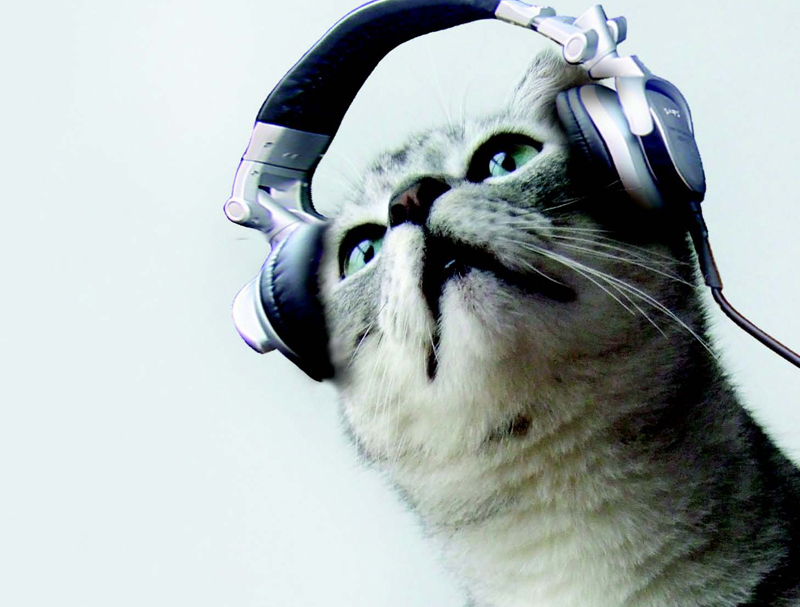Does your cat mellow out when you play Mozart? She’s not alone. They may not be able to hum along, but felines are very responsive to music.
Understanding the connection between animals and music is a journey that began with my cat, Osborn. From the day I brought him home as an adopted kitten, Osborn always moved to my side when I practiced the guitar or sang. And whenever I played soft music, I would always find him peaceably resting. Osborn showed me that hearing is a guiding sense for cat behavior, and that the language of music has a positive effect on feline well being. From that time onward, I have been researching and discovering why this is so.
The amazing feline ear
Animals hear sounds differently than we do. Have you ever wondered why your cat magically slips away before there’s a knock on your door, or gets agitated before there’s any sign of a thunderstorm? Sound and noise travel through the air at high and low frequencies and volumes that humans can’t hear, but cats can. Their astounding ability to detect the highest frequencies and faintest sounds is a built-in evolutionary survival tactic.
A cat’s upright ears give her acute hearing and help her capture frequencies we can’t detect. Additional muscles allow her to rotate her ears for surround sound-like hearing. In fact, observing your cat’s ears is the best way to know what she is hearing and feeling. Her response to sounds and noise is an important way for her to communicate her feelings about the world.
Cats like to sit in the “sweet spot”; this is where music, as it’s reflected from the walls, comes to a central point from the sound source.
Cats also do not have the same audio/spatial localization ability as humans have. While they’ll come running to the kitchen when they learn what sound the door to the food cupboard makes, they are not able to identify the location of jarring sounds. They feel such sounds intensely in their bodies. Humans, meanwhile, use analytical thinking to determine if a sound is harmful or not, and where it’s coming from.
Sound and behavior
It’s important to be aware of your cat’s acute auditory senses. Responses to low frequencies such as loud drums from a sound system can easily generate stress because to the cat it may mean “get ready to flee”. For cats, very low or very high frequency information and resonant vibrations are indistinguishable from a loud vehicle or crack of thunder. They only know they have to react and get away! This uncertainty, combined with the fact that they cannot locate the source of these vibrations, causes them to react with defense instincts.
Because of the sensitivity of feline hearing, your cat may react to agitating sounds you may not even be aware of. Negative behaviors such as furniture scratching, wetting outside the litter box, aggression and excitability while home alone can signal a reaction to unpleasant sounds. These can include rumblings from the furnace, trucks passing on the road, high frequencies emitted from computers and electronic appliances, and other sounds that are part of domestic living.
Music to her ears
Music is a language that animals relate to. In my research, I have tested different types of music and found that felines prefer long sustained tones and harmonies at a moderate to low volume to maintain a state of relaxation. Releasing themselves into calming music gives their alert instincts a chance to rest. Gentle classical or relaxation music are good choices; avoid loud music with a lot of fast rhythms and percussion, especially bass drums. I have created a CD specifically for animals called Relaxation Music for Dogs and Cats.
Amazingly, cats not only understand the soothing qualities of music for enhancing their meditative resting state, but they also like to sit in the “sweet spot” of the room. This is where music, as it’s reflected from the walls, comes to a central point from the sound source. Cats are discerning, of course. They will move away from music they don’t find pleasing, and gravitate to music they do.
When to play it
Calming music in the feline environment offers several advantages:
- it elicits relaxation by limiting frequency content in the air.
- it lowers stress levels during thunderstorms and while home alone.
- it masks jarring sounds and noises that trigger agitated behaviors.
Music is a comfort to adopted cats while they adjust to their new home and nesting spots. Put on a CD to attract your cat to a place or room where you want her to be or stay. Use the music for soothing her if she seems stressed or restless. “We had three little foster kittens at an adoption event who were very upset at having to be there,” says Dr. L. Carey of the Litchfield Veterinary Hospital in Connecticut. “There were a lot of new noises and people. We set up the CD player and within five minutes all three kittens were asleep, completely relaxed.” Dr. Carey adds that music also has a significant calming effect on his hospitalized patients. “We have found it has helped to reduce their anxiety while away from their families.”
Use music when introducing one cat to another. Music permeates the air with sound waves and distracts the intense smelling session between the two felines.
If your cat doesn’t go out for a nocturnal prowl, relaxation music is a very useful tool to play at low volume near your cat’s favorite spot. It masks the night sounds from outside that she would instinctively respond to. Whether you live in an urban apartment or a suburban or country home, outside animal noises often elicit excitable instinctive behavior in cats.
Some cats have motion sickness while traveling in the car. Music can help keep both you and your cat calm. “My tabby cat, Oliver, just hated the movement of the car and I could hear from the back seat a sound that was just like the word ‘horror’!” says one cat person I know. “Once the music started, he became calmer and settled down.”
As the expression goes, we can’t herd cats. But we can modify their behavior and help keep them relaxed and happy, with music.







No Comment